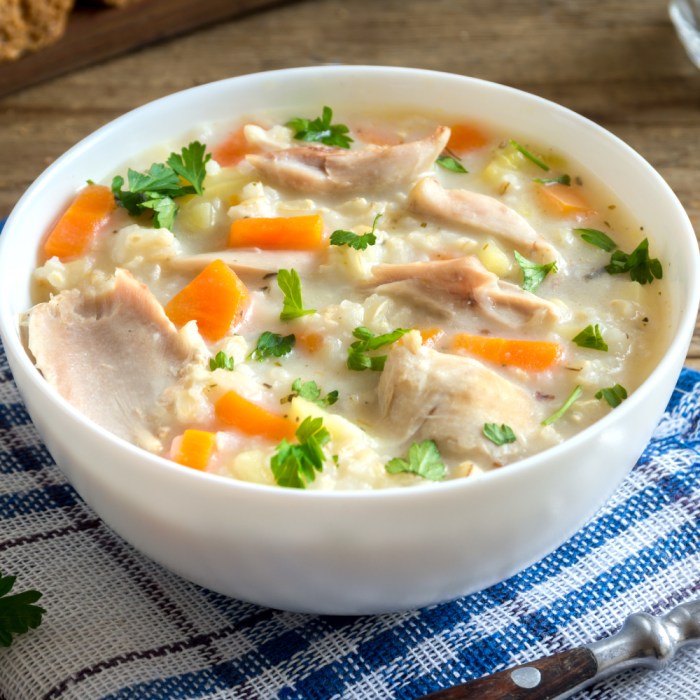Understanding “Cream of Chicken Soup”
Cream of chicken soup chicken recipe – Cream of chicken soup is a classic comfort food, known for its creamy texture and savory flavor. Its appeal lies in its versatility and relatively simple preparation.
The typical flavor profile is rich, savory, and slightly tangy, with a balanced blend of chicken, vegetables, and cream. The key ingredients commonly found include chicken broth, cooked chicken, vegetables (such as carrots, celery, and onions), and a thickening agent to achieve the characteristic creamy consistency. This can be achieved through the use of cream, milk, or a roux (a mixture of butter and flour).
Cream of Chicken Soup Variations
Homemade cream of chicken soup offers greater control over ingredients and flavor, resulting in a richer, more nuanced taste compared to canned varieties. Canned soups, while convenient, often contain higher levels of sodium and preservatives and may have a less complex flavor profile. Homemade versions allow for customization with fresh herbs and spices, resulting in a more vibrant and flavorful soup.
The texture of homemade soup is generally smoother and creamier due to the careful control of thickening agents.
Cream of Chicken Soup Texture and Consistency
A good cream of chicken soup should have a smooth, velvety texture, free from lumps or grains. The consistency should be thick enough to coat the spoon but not so thick as to be difficult to eat. The ideal consistency is achieved through careful control of the thickening agent and cooking time.
Chicken Selection and Preparation
The choice of chicken significantly impacts the soup’s flavor and texture. Several chicken types are suitable, each with its own advantages and disadvantages.
Suitable Chicken Types
- Rotisserie Chicken: Convenient and flavorful, offering immediate use. However, the flavor might be slightly less intense compared to freshly cooked chicken.
- Bone-in, Skin-on Chicken Breasts: Yield a richer broth and more flavorful meat. Requires longer cooking time.
- Boneless, Skinless Chicken Breasts: Quick cooking time and leaner meat. May result in a less flavorful broth.
- Chicken Thighs: More flavorful and moist than breasts, but require longer cooking time.
Chicken Preparation
- Roasting: Preheat oven to 375°F (190°C). Season chicken with salt, pepper, and herbs. Roast until cooked through (internal temperature of 165°F/74°C).
- Poaching: Gently simmer chicken in seasoned water until cooked through. This method yields a more delicate flavor.
- Shredding: Once cooked, let the chicken cool slightly. Shred the meat using two forks, discarding skin and bones.
Maximizing Chicken Flavor
To enhance the chicken’s flavor, consider brining it before cooking, or adding aromatics like onions, garlic, and herbs to the cooking liquid.
Chicken Cooking Times and Methods, Cream of chicken soup chicken recipe

Source: everydfood.com
| Chicken Cut | Cooking Method | Approximate Cooking Time |
|---|---|---|
| Bone-in, Skin-on Breast | Roasting | 45-60 minutes |
| Boneless, Skinless Breast | Poaching | 20-30 minutes |
| Chicken Thighs | Roasting | 50-70 minutes |
| Rotisserie Chicken | N/A | Pre-cooked |
Vegetable and Broth Choices: Cream Of Chicken Soup Chicken Recipe
Vegetables contribute significantly to the soup’s flavor, nutrition, and visual appeal. Aromatic vegetables such as onions, carrots, and celery form the base of many cream of chicken soups.
Complementary Vegetables
- Onions: Provide a base of sweetness and savory notes.
- Carrots: Add sweetness and vibrant color.
- Celery: Offers a subtle earthy flavor and texture.
- Mushrooms: Enhance the umami flavor.
- Leeks: Add a mild onion flavor.
These vegetables should be finely chopped or diced for even cooking and easy blending.
Broth Selection
Chicken broth provides a rich, savory base, while vegetable broth offers a lighter, vegetarian alternative. Homemade broth generally provides superior flavor and control over sodium content.
Homemade Chicken Broth
Simmer chicken bones, scraps, and vegetables (onions, carrots, celery) in water for several hours. Strain the liquid to remove solids. This process extracts maximum flavor and nutrients from the ingredients.
Creaming and Thickening Techniques
Achieving the signature creamy texture is crucial. Several methods can achieve this, each with its unique characteristics.
Creaming Methods
Heavy cream provides richness and a luxurious mouthfeel. Milk offers a lighter creaminess. A roux, a mixture of butter and flour cooked together, creates a thicker, more stable creaminess.
Making a Roux
Melt butter in a saucepan over medium heat. Gradually whisk in flour, ensuring no lumps form. Cook for 2-3 minutes, stirring constantly, until the mixture is smooth and lightly golden. A typical ratio is 1:1 butter to flour.
Thickening Agents
Cornstarch creates a smooth, glossy texture, while flour can result in a slightly thicker, more opaque soup. Cream adds richness and a creamy texture.
Achieving Desired Creaminess
To prevent lumps, whisk the thickening agent into a small amount of cold liquid before adding it to the soup. Stir constantly while adding and cooking to ensure even distribution.
Recipe Variations and Flavor Enhancements
Cream of chicken soup lends itself to endless variations.
Unique Variations
- Creamy Tomato Chicken Soup: Incorporate diced tomatoes and tomato paste for a tangy twist.
- Creamy Chicken and Wild Rice Soup: Add wild rice for added texture and nutty flavor.
- Creamy Chicken and Spinach Soup: Stir in wilted spinach for a boost of nutrients and vibrant green color.
Flavor Enhancers

Source: licious.in
Herbs like thyme, rosemary, and parsley, along with spices such as paprika, garlic powder, and onion powder, complement the soup’s flavor profile.
Dietary Adjustments
For a low-sodium version, use low-sodium broth and reduce added salt. Gluten-free options are easily achieved by using gluten-free flour for the roux (or omitting the roux entirely).
Visual Presentation
Serve the soup in warm bowls, garnished with fresh herbs (such as parsley or chives), a swirl of cream, and perhaps a few croutons for added texture.
Serving Suggestions and Accompaniments
Cream of chicken soup is a versatile dish suitable for various occasions.
Accompaniments
- Crust bread
- Crackers
- Grilled cheese sandwich
- A side salad
Serving Occasions
Serve it in a casual setting with crusty bread, or elevate it for a formal event with elegant garnishes.
Serving Temperature
Serve hot, but not boiling. The ideal temperature allows for comfortable enjoyment without burning the mouth.
Presentation Enhancements
- Garnish with fresh herbs.
- Add a swirl of cream.
- Serve in elegant bowls.
- Use crusty bread as a dipping tool.
Visual Representation of the Recipe
The raw ingredients display a range of colors and textures: the pale yellow of the chicken breast, the vibrant orange of the carrots, the crisp green of the celery, and the translucent white of the onions. During cooking, the vegetables soften and release their colors into the broth, creating a rich, golden hue. The finished soup is a smooth, creamy consistency, with a pale golden color, speckled with flecks of vegetables and shredded chicken.
The ideal consistency is thick enough to coat the spoon, yet still fluid enough to pour. The color should be a warm, inviting golden yellow, indicating the richness of the broth and the creaminess of the finished product.
FAQs
Can I use leftover cooked chicken?
Absolutely! Leftover roasted or poached chicken works perfectly. Just shred it before adding it to the soup.
What if I don’t have chicken broth?
Vegetable broth can be substituted, but chicken broth will yield a more authentic flavor. You can also use water, but the flavor will be less rich.
How can I make the soup thicker?
Cream of chicken soup, a classic comfort food, often features a creamy, flavorful broth. For a heartier variation, consider adding dumplings; if you’re looking for a great dumpling recipe, check out this fantastic chicken soup with dumplings recipe. Returning to our cream of chicken soup, remember that the richness of the broth is key to its success, achieved through careful simmering and the addition of cream or milk.
If your soup is too thin, you can simmer it uncovered for a while to reduce the liquid. Alternatively, mix 1-2 tablespoons of cornstarch with a little cold water to form a slurry, then whisk it into the simmering soup until thickened.
Can I freeze cream of chicken soup?
Yes, cream of chicken soup freezes well. Allow it to cool completely before storing in airtight containers for up to 3 months.
